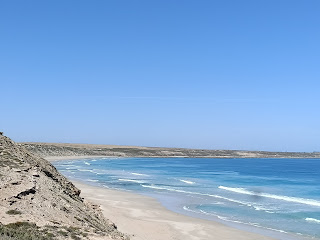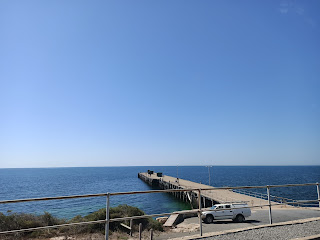After a truly lovely coffee, plus cake, at our favourite cafe in Moonta, we set forth south, in the hope that our long held negative view of the Yorke Peninsula would disappear as we looked at the area with fresh eyes. And to cut a long story short, we were suitably impressed Perhaps after all our travels we are less critical. And we are too, especially of South Australia.
The next stop was Minlaton, where we finally ate pasties that were packed full of ingredients, namely meat, potato, swede (I think), and onions, and herbs. Locally made too.
I must mention at this point about the dog friendliness on the peninsula. Not only did they allow dogs on the little train in Moonta, but people made a fuss of them at every opportunity. As Piper was very shy she was overwhelmed by all the attention, and tried to disappear under our table at the first opportunity. But we were impressed and certainly added to our positive feelings about the peninsula.
After travelling through seemingly endless fields of crops, which were fields of stubble at this time of year, we arrived at our destination. The camping ground at Corny Point, which is on the top of the foot, on the west coast, and in the Spencer Gulf. If you look at the map of the Yorke Peninsula there is a definite foot at the bottom of the peninsula, a knobbly foot, perhaps a bit arthritic.
We settled our van on our patch of dust, so dry in March, knowing that a fair amount of the dust would end up in the van. There were areas of green grass, but unfortunately when we arrived they were taken up with other caravaners.
After touring around the UK and Europe, where there is always a reasonable gap between campers, and often there is a hedge or a line of trees between sites, I cannot get used to the way camping grounds here have no space between campers. There is often only enough space to put an awning up between vans. They literally cram people in to the grounds.
The photographs below were taken after most of the people left, and we were left with a reasonable view.
Piper relaxing on her bed.Our view to the left was very good, especially of the red sunsets.
There were two school groups there, and the students were very well behaved, thank goodness. The students were learning how to surf, so were out most days. I was impressed as each student had to be self sufficient, and provide their own food and cook it as well. No catering provided by staff at the schools. They took over the excellent camp kitchen.
An early view of the sunset with a windmill in front. It was a very rural location.
Our view of the facilities, which included a huge camp kitchen and ablution block. At the front, to the right, and not included in the photographs, were the camping sites of four men, one with a caravan that looked as if it was his home, one with a swag tent and a very active large dog, which Piper was terrified of, and two men in their tents. They spent their days fishing or surfing. Lots of interesting tales.
Corny Point once had a thriving community, with a church, a hall, a sports ground and a tavern. When I read the information boards there were descriptions of social events, namely dances, sports days and picnics, mostly held in the 1950s, which were no longer relevant these days.
The sports ground! Now used only used for cricket, but there was a battered looking tennis court and an unused bowling green also. The soil was barren, and the bore water sprinklers encouraged a few weeds to grow. And talking about water. This was another area were the bore water was unpalatable, and not even the filter system in the caravan took the taste away. We bought expensive spring water from the office. We must remember to buy boxes of spring water before we leave home. A little bit of forward planning is definitely needed, I think.
A flock of sheep being herded past on the road.
To see the best of the Yorke Peninsula it is important to go off the bitumen roads, which run between the main towns. This is especially so down in the foot of the peninsula. The best views and experiences were had when taking the gravel roads, but we found talking to many people travelling in their expensive motor homes, or driving expensive cars, that they were not prepared to do this.
The road around the western part of the foot does not follow the coastline as such, so it was a matter of driving into each of the beaches. After travelling from Corny Point lighthouse, and the accessible beaches there we drove out to the bitumen road, and from there drove into Swincer Rocks, Gleesons Landing, Daly Head, Ella Rock (Formby Bay), and Gym Beach. All the beaches are used by surfers and people fishing, although there are signs warning of currents and tows.
The other end of the same beach, where it was possible to see the rips. The rips show up as smooth water, without breakers, and often darker than the surrounding water.
We stopped at Gleesons Landing for lunch, which we ate in the car due to the high number of bush flies around. Such wimps! This is a bush camping area, one of the many available to camp in, through paying a small fee. There are restrictions on the number of campers and the wardens keep a close eye on who is there. Luckily the people in the van in front of us were off sightseeing. They might not have been happy with us invading their spot.
The next day we drove along the top of the foot, which again required a trip into all the beaches. The beach below, 'The Pines' is a popular fishing spot, but at low tide it certainly is a long way out to the deep water.
Point Turton, once a small holiday village comprising of shacks, now boosting many large holiday houses.
And then we drove across the foot to the heel of the peninsula to the town of Edithburgh, the town where we stayed at in the late 1980s, in the middle of winter. But this time we had blue skies and sunshine and I must say the town looked quite different. Lunch in the car, no picnic seats here, but a lovely view of the jetty. A great area for scuba diving due to the colourful reefs, plus a few sharks too, I am sure of this.
Another beautiful beach.
After another pleasant evening at the campsite we drove back to Aldinga Beach. We stopped at Warooka, a pleasant little town, for coffee. A very welcoming bakery, for sure, and the bread, pies and cakes were made on the premises. But they looked a little strange, so we opted for a coffee only, which was very good. I think we missed our chance to try something a little different. But after my experience with the sustainable sausages in Maree, I am a little hesitant about trying anything new.














































